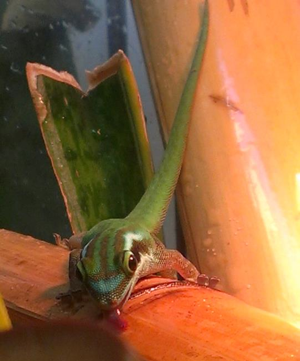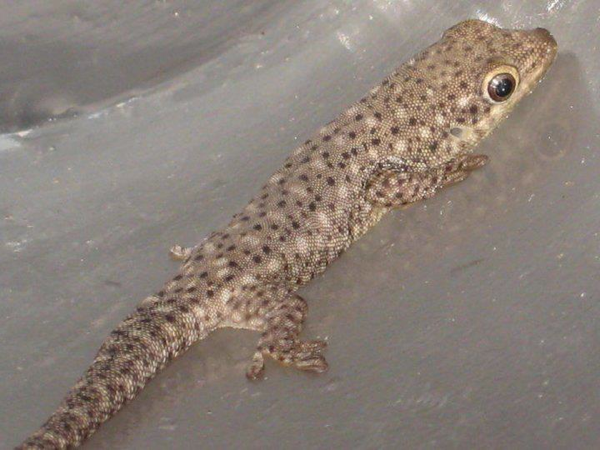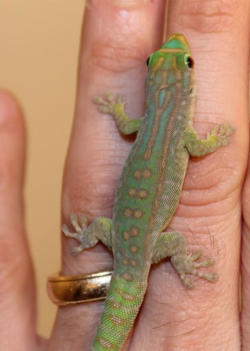Editor’s note: The issue of habitat destruction and threatened extinction of many gecko species looms large in the world these days. Matt Schaefer was good enough to respond to the Editor’s questions about his efforts to combat gecko extinction and his philosophy of how it should be done.
What species do you breed?
We are currently working with Phelsuma abbotti chekei, Phelsuma borbonica borbonica, Phelsuma borbonica (agalegae) mater, Phelsuma breviceps, Phelsuma cepediana, Phelsuma guimbeaui, Phelsuma inexpectata, Phelsuma klemmeri, Phelsuma kochi, Phelsuma laticauda, Phelsuma madagascariensis, Phelsuma nigristriata, Phelsuma robertmertensi, Phelsuma standingi, and Phelsuma sundbergi ladiguensis. We intend to launch a few more projects before the end of the year.

What is their current status in the wild?
Many Phelsuma species are seriously imperiled in their natural ecosystems due to habitat fragmentation, degradation, destruction, resultant genetic isolation from other populations, and invasive species. Since day geckos are largely endemic to particular islands, including the Comoros, the Mascarenes, and Madagascar (though a few species have been introduced elsewhere), they are especially impacted by these pressures. According to the IUCN Red List of Threatened Species and independent research, a large number of extant species we work with are classified as either threatened, vulnerable (Phelsuma breviceps, Phelsuma nigristriata, and Phelsuma standingi) endangered (Phelsuma borbonica spp., Phelsuma klemmeri ,and Phelsuma robertmertensi), or critically endangered (Phelsuma inexpectata), and soon may be extirpated from natural ranges or extinct in the wild. Phelsuma cepediana and Phelsuma guimbeaui should also be included in this list due to their rarity in captivity, the role of Phelsuma cepediana as a native pollinator, and declining habitat and populations on Mauritius.

What have you accomplished with your breeding program so far?
We specialize in the cooperative captive husbandry, propagation, and the conservation support of rare and imperiled herpetofauna in their natural habitat. We began working with Phelsuma in 2008, when we obtained our first Phelsuma standingi and Phelsuma kochi from Kurt Lantz (www.reproom.com). As we found them to be prolific breeders, we started other projects and obtained new species from experienced and successful keepers like Leann Christenson (www.daygecko.com), Kurt Lantz, Preston Garbett, Jason Pierce, Julie Bergman(www.geckoranch.com), Melody Hartley (HeartSong Sanctuary), and John Woodward. We are extremely grateful to those we have worked with, to the many pioneers of Phelsuma husbandry, and apologize if we have not credited everyone! Over the past three years, we have intensely focused on working with species that are rare in collections in the United States of America and are of conservation significance. We began acquiring diverse groups of Phelsuma borbonica spp., Phelsuma cepediana, Phelsuma guimbeaui, Phelsuma klemmeri, Phelsuma robertmertensi, and Phelsuma standingi. Last year, we had the opportunity to acquire two pairs of Phelsuma inexpectata and Phelsuma breviceps. One pair of Phelsuma inexpectata, consisting of an older male and three year old female, have begun producing regularly, which is very exciting. This is our first year pairing mature male Phelsuma borbonica borbonica, Phelsuma nigristriata, and Phelsuma breviceps with their female conspecifics, but believe that a female Phelsuma breviceps is presently gravid. With the exception of the three aforementioned first season pairings, we are regularly producing the other species we keep. Though we occasionally make pairs or individual animals available, we are largely holding back animals this year to grow and diversify the collection so that we can consistently offer unrelated animals in the future.
How do you deal with the challenges of acquiring a diverse gene pool?
Most dedicated Phelsuma keepers maintain excellent records detailing the lineage, date the eggs were laid or discovered, hatch dates, and sex. The original Phelsuma cepediana cooperative assigns an individual letter and number identity to known animals and offspring. This is essential when dealing with captive populations that originated from a small number of animals and are still present in low numbers throughout all our collections. We mark all cages, assign identification to all offspring, and keep our records on both paper and in an online database. When knowing the lineage, keepers are able to create desired pairings, assuming the male and female will be agreeable enough with one another to be productive, and coordinate line trades, breeding loans, or transactions with other keepers. Aside from observing and working directly with the animals, this is one of the most rewarding aspects of keeping Phelsuma. We can maintain or increase genetic diversity through selective pairings and cooperative strategic planning.
What do you think should happen with captive bred populations as the wild caught populations become extinct?
As enthusiasts, hobbyists, and keepers, it is essential that we support habitat preservation, conservation research, and reintroducing herpetofauna (and other wildlife) into their natural ranges. We believe keepers can make a significant impact if we collectively donate funds, even from our sales, to legitimate organizations and researchers already working on in the field to learn more about and preserve the species. This is happening, for example, with projects launched by Exo Terra, the Blue Iguana Recovery Program (http://www.blueiguana.ky/), Mampam Conservation (www.mampam.com), which has examined wild populations of Varanus olivaceus and other frugivorous varanid lizards, and many more individuals who care about these creatures. If we have the opportunity to work with rare or endangered species in captivity, we, in most cases, have the privilege and responsibility to develop sustainable and ongoing captive breeding programs in the context of community. This should drive us to connect and network with other keepers, working together in the best interest of the species, as the other aforementioned keepers have advocated and personally lived out. We should view each species we work with as a long-term project and consider what valuable insights or novel approaches we can contribute to our total understanding. As populations decline in the wild, we should, ideally, be developing sizable breeding populations among a cooperative of keepers, so that, if a reintroduction is possible, we have enough animals to establish a (and likely multiple) founding wild population(s) while maintaining a self-sustaining captive population. We can all start by obtaining multiple pairs from each species we work with, commit to breeding them (or learning how to do that more reliably with some species), and devoting enough space for offspring and future pairings of, desirably, unrelated animals. That may be more easily said than done, but, if we work with others, we can know who has which species, how many individuals of that species, and the lineages, as we all have different parameters regarding our time and available space. While there are many governmental and ecological issues surrounding reintroductions, including success and failure rates, which available scientific literature speaks to, it is vital that we establish thriving, diverse captive populations while working to preserve primary forests and other habitats, even if from afar. We personally believe we all have an awesome responsibility to serve as stewards of creation and desire to encourage others to value, care for, and instill appreciation for the natural world in following generations.



Dear Matt,
Thank you for such an inspiring article on the work that you do, you encapsulate what so many of us hobbist do and aspire to with our own collection.
I do have a nagging question as to how we can know from the start how the pairings that we have are not related in the first place , considering they were all wc.?Is there a genetic testing that is avaible without costing the sky?
I am working with Lygodactylus williamsi for the first time,( 12 pairs) although I have been keeping Reps & Amps on/off for decades. Having kept some Phelsuma species before, I’m using their husbandry to raise the many offsprings that I have now.
Sincerely,
Stuart
My wife and I live on the north shore of Kauai at elevation 420 feet. I have lived on my farm of 5 1/2 acres for 10 years, and for the first time I found a Phelsuma guimbeaui in my back yard. It’s a beautiful little animal. What may have attracted it to be here is my wife throwing mango peelings out there to attract chickens. We want the chickens around because they eat centipedes. We get big centipedes here.
I have no interest in collecting or keeping any animal captive, but unless this little guy is an environmental problem, I’d like to encourage them. What do you think we should do, if anything.
As I understand it, since Hawaii’s climate (or at least parts of it) is similar to that of Madacascar (or at least some parts of it), it can support a variety of reptiles from that tropical rainforest area. There are a number of Phelsuma species (giant day gecko and P. laticauda) that live in the wild in Hawaii because they’re been released to the wild by misguided gecko keepers. There’s probably nothing special you need to do. The gecko you found will either survive or not survive the outdoor conditions and it appears to be in good company. Unless you want to keep a wild caught pet, just leave it alone in its environment.